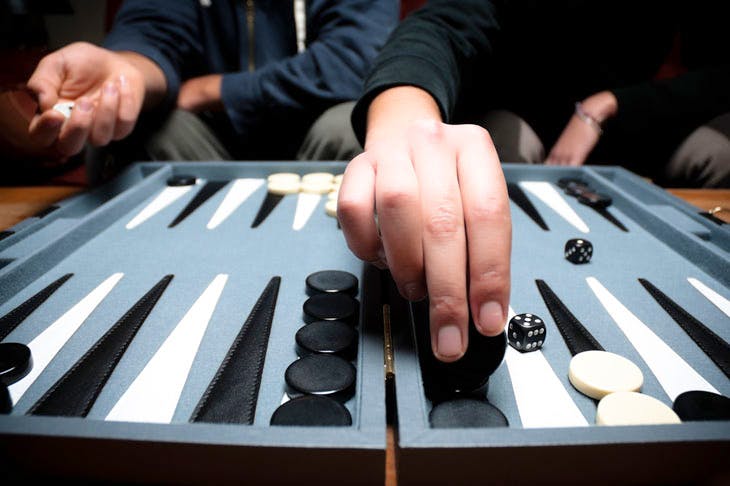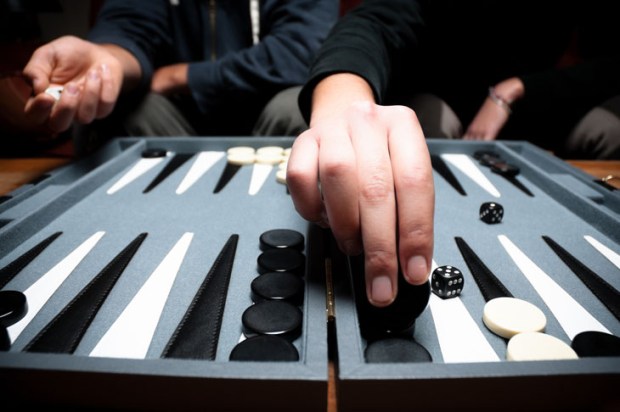In backgammon, a blot is a single checker, sitting alone and unprotected. This is a sly title for this sly novel (which was published in the US as the more literal A Gambler’s Anatomy). The hero, Alexander Bruno, is a single, exposed man, and a professional backgammon player. He also suffers from an eye condition: there is a floating blank space in his line of vision, which means that he cannot see that which he looks directly at. Lastly, as a term drawn from the specific vocabulary of the game, the title suggests Lethem’s deep interest in the conventions and insider language of obsessions and professions.
As the novel opens, Alexander Bruno is on his way to play backgammon with a rich German industrialist in the outskirts of Berlin. On the ferry, he flirts with a German girl. Bruno is an attractive man, although his charms have somewhat fallen to ruin. He looks like Roger Moore ‘or the bass player from Duran Duran’, and his gambling skills, too, have recently diminished. At the industrialist’s house, the two men play, and drink, and after some minor Teutonic kinkiness involving dill sandwiches and a leather clad prostitute, Bruno collapses.
The book is structured around a series of games of backgammon. The second takes place in Singapore, and here Bruno plays against his old school friend Keith Stolarsky, who is now a millionaire property developer in Berkeley, California. Deep in debt to Stolarsky, and needing specialist medical care for the removal of the blot —which is described in an eye-watering surgical sequence — Bruno returns to Berkeley, where he was from. In California, the backgammon games become increasingly antic and absurd: a round of strip backgammon, and a version played on a grill with the mini hamburgers Americans call sliders in the place of checkers.
The novel relishes the specialist language of backgammon. There is ‘a blitz’, where one plays wildly, attacking the opponent’s checkers, and the approach known as ‘pure play’. In Lethem’s definition, ‘He slotted checkers and tried to cover them, working to build primes with the monolithic purposefulness afflicting those who believe they’ve discovered a system or cracked a code.’ This is a style of play that Bruno looks down on, but it might offer a key to the novel as a whole, divided between those who play literally and those who play tricks. The novel is structured like a game, with the numbers of the chapters doubling each other — one, two, four, eight — in an allusion to the game’s doubling dice. And after each game, Bruno’s losses double.
Lethem’s previous novels have been acutely aware of the rules and conventions of storytelling. He writes what academics sometimes snootily refer to as genre fiction, which simply means stories that borrow from lowbrow genres, and particularly in Lethem’s case science fiction. His best novel, Motherless Brooklyn, is a crime thriller and pulp novel whose central gangster suffers from Tourette’s, which shouldn’t be as funny as it is. But in The Blot, all these metaphors and symbols threaded throughout — for sight and blindness, risk, dice and games — culminate in a novel which is slightly contrived. Lethem can turn a sentence like few other living writers; again and again in The Blot, there are little gems of clean, elegant style. But despite this novel’s many strengths — its wit, its playfulness, its amazing imagination — it feels like Lethem is playing a game instead of telling a story.
Got something to add? Join the discussion and comment below.
Get 10 issues for just $10
Subscribe to The Spectator Australia today for the next 10 magazine issues, plus full online access, for just $10.














Comments
Don't miss out
Join the conversation with other Spectator Australia readers. Subscribe to leave a comment.
SUBSCRIBEAlready a subscriber? Log in